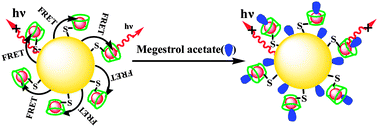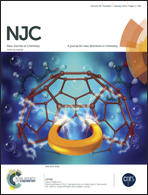A novel water-soluble quantum dot–neutral red fluorescence resonance energy transfer probe for the selective detection of megestrol acetate†
Abstract
A novel water-soluble beta-cyclodextrin (β-CD)-functionalized ZnS quantum dot (QD)–neutral red (NR) fluorescence resonance energy transfer (FRET) probe for the selective determination of the concentration of megestrol acetate in river water has been developed. The water-soluble and low-toxicity β-CD-functionalized ZnS QDs were first synthesized, and their characterization was confirmed by transmission electron microscopy and infrared, UV-vis and fluorescence emission spectra. The NR molecule can enter the cavity of the β-CD anchored onto the surfaces of the ZnS QDs in its neutral form, forming the FRET probe. Compared with other steroid hormones, the probe can selectively recognize megestrol acetate at a lower concentration level. The possible underlying mechanism of the probe with nine steroid hormones was discussed in detail. The fluorescence quenching fractions of the probe presented a satisfactory linearity with the concentrations of megestrol acetate, and its limit of detection was calculated to be 0.0083 μM. Coupled with sample pretreatment procedures, the probe has been applied to the determination of megestrol acetate in river water. The average recoveries of megestrol acetate in the spiking levels of 0.001 μM–10 μM ranged from 97% to 110% with a relative standard deviation below 15%, which was similar to those for HPLC or MS techniques.


 Please wait while we load your content...
Please wait while we load your content...